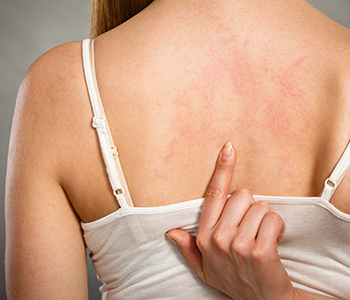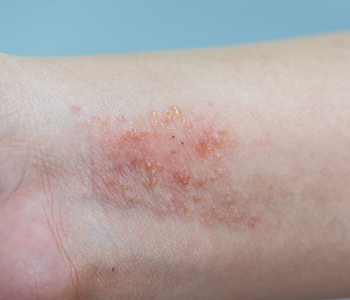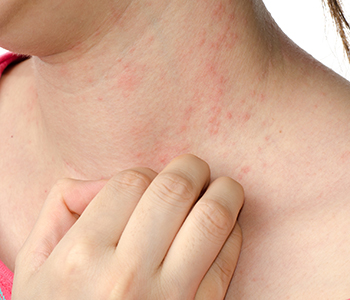Algonquin doctor understands different skin rash types for effective treatment
Posted by Dr. Vikram Khanna
Here, Dermatology Specialists of Illinois covers some of the types of skin rash commonly seen, and respective treatment options at the Algonquin, IL practice.
Atopic dermatitis
 You may know this type of condition as eczema, a source of severe itching that often flares at night; red to brownish-gray patches of dryness and scaling; and red, fluid-filled bumps.
You may know this type of condition as eczema, a source of severe itching that often flares at night; red to brownish-gray patches of dryness and scaling; and red, fluid-filled bumps.
Some dairy, nuts, fish, and grains can occasionally be triggers, especially among children. In our climate, extremely low or high humidity is the most common trigger. Other potential allergens include dust and pollen. It’s important to avoid these items whenever possible. Take steps to minimize triggers with special cleaning and lifestyle modifications, including:
- Frequent moisturizing, at least twice a day.
- Limit bathing to no more than 15 minutes.
- Use water that’s not too hot for cleansing.
- Choose gentle soaps, which don’t strip natural oils.
- Apply moisturizer while your skin is still damp.
Contact dermatitis
It’s common for those with eczema to also have the uncomfortable dry and cracked skin, swelling, redness, and blisters characteristic of contact dermatitis. The most common, non-allergic form of this condition is caused by exposure to a substance that damages the protective layer of skin and produces a reaction. Very strong irritants may cause a reaction after one exposure, whereas repeated exposure to even mild irritants can cause a reaction over time. Some patients may develop a tolerance to substances over time. It’s best to practice avoidance or precautions around identified irritants, which often include:- Industrial solvents
- Bleach
- Fertilizer
- Rubbing alcohol
- Sawdust
Hives
 Also called urticaria, this skin reaction ranges from itchy dots to blotches that are many inches around. A closely related condition, angioedema, produces swelling that affects the deeper parts of the skin. It usually occurs on the face, around the eyes and mouth, and on the cheeks. Even when these symptoms resolve on their own, they typically don’t cause lasting damage to affected areas.
Also called urticaria, this skin reaction ranges from itchy dots to blotches that are many inches around. A closely related condition, angioedema, produces swelling that affects the deeper parts of the skin. It usually occurs on the face, around the eyes and mouth, and on the cheeks. Even when these symptoms resolve on their own, they typically don’t cause lasting damage to affected areas.
Hives are frequently associated with stress. But there are many other triggers, including:
- Several foods - peanuts, shellfish, eggs, milk
- Allergens - pet dander, pollen, and venom from stinging insects
- Drugs - penicillin, aspirin, blood pressure meds.
Mild cases may benefit from the same healthy skincare that improves the symptoms of other types of rashes, such as wet compresses to cool burning and itchy skin, and to prevent the scratching that can lead to bacterial infections.
Don’t live with flare-ups - Call Dermatology Specialists of Illinois!
Causes are as seemingly innocuous as friction that produces chafing and heat or moisture, to chronic conditions like psoriasis. For the short-term relief and long-term resolution that you deserve, schedule a consultation with Dr. Khanna.
Related Articles
- Effective treatment for skin rashes available with dermatologist in Algonquin, IL
- Algonquin doctor understands different skin rash types for effective treatment
- Algonquin, IL residents learn the importance of consulting a physician for skin inflammation





















